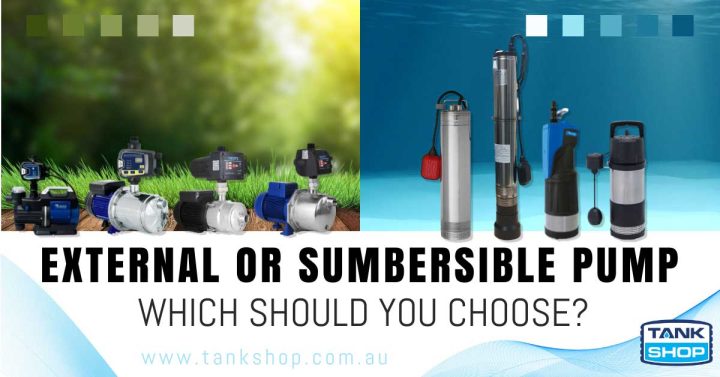Water Tank Buying Guide
Should You Choose an External or Submersible Water Tank Pump?
When it comes to getting the most from your rainwater tank, selecting the right pump is crucial. While both external and submersible pumps can effectively deliver water to your home, each type has distinct advantages that might make it perfect for your specific situation. This article explores the key benefits of each option to help you make an informed decision.
External Pumps
External pumps, mounted beside your tank, have been the traditional choice for decades. These surface-mounted units are positioned in a weatherproof location near your tank and draw water through an inlet pipe before pressurising it for household use.
Advantages of external pumps include:
- Lower initial purchase cost
- Easy access for maintenance
- Simple installation process
- No impact on tank capacity
- Straightforward troubleshooting
Submersible (In-Tank) Pumps
An increasingly popular option, submersible pumps are installed directly inside your water tank, operating beneath the water’s surface. They’re engineered to push water up through the tank and into your home’s plumbing system, working quietly and efficiently from within.
Key benefits of submersible pumps include:
- Whisper-quiet operation
- Protected from weather extremes
- Higher energy efficiency
- Space-saving installation
- Clean, hidden appearance
Key Considerations When Choosing Your Pump
- Price / Budget – External pumps typically have a lower upfront cost, though they may require additional components like protective pump cover and flexible connections. Submersible pumps cost more initially but include waterproof housing and may need fewer accessories.
- Installation Location – Consider your available space and local weather conditions. External pumps need protection from the elements, while submersible pumps are naturally sheltered inside the tank.
- Noise Preferences – If pump noise is a concern, especially near bedrooms or living areas, submersible pumps offer superior quiet operation. External pumps, while improved in recent years, will always generate more noticeable sound.
- Maintenance Requirements – External pumps win for accessibility – they’re easy to inspect and service. Submersible pumps require more effort to access, typically involving some tank disassembly for maintenance.
- System Efficiency – Submersible pumps often achieve better energy efficiency since they’re already primed and don’t need to work against gravity to draw water up. External pumps must first pull water to their level before pressurising it.
Ensuring Continuous Water Supply with Rain-to-Mains Systems
A Rain-To-Mains System is a crucial component for a plumbed in rainwater tank. This intelligent device monitors your tank’s water level and automatically switches between tank water and mains supply when your rainwater levels are low or during a power outage, ensuring uninterrupted water supply to your home appliances (toilets, laundry, etc.). Most importantly, it prevents your pump from running dry and potentially becoming damaged.
Rain-To-Mains Systems can be installed with both external and submersible pumps, offering:
- Automatic switching between water sources
- Protection for your pump
- Consistent water pressure
- Peace of mind during dry spells
- Compliance with local plumbing regulations
Ready to Choose Your Water Tank Pump?
Both external and submersible pumps can provide reliable water pressure for your home. Your choice should align with your specific needs but whether you opt for the traditional reliability of an external pump or the quiet efficiency of a submersible unit, either choice can effectively deliver your harvested rainwater where you need it. Browse our range of water pressure pumps here.



